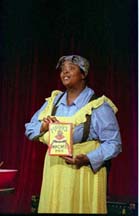
Dorothy Chansky
Reconsidering Shortnin' Bread
 |
| Michelle
Matlock in "The Mammy Project." Photo by Amy Gordon |
Review of "The Mammy Project"
by Dorothy Chansky
Presented by Roundtable Ensemble
at American Theatre of Actors
314 West 54th Street, New York, NY 10019
January 16-February 10, 2007 (in repertory; Mondays at 8:00, Fridays at
10:30, Saturdays and Sundays at 1:00 p.m.)
Tickets: $18: (212)352-3101; Reservations (212)696-6699; www.roundtableensemble.org
The best way to defuse a stereotype is to decline it, according to cultural theorist Mireille Rosello. On an obvious level, "decline" means just refuse to cooperate. More subtly, it refers to the sort of declension one performs on a verb (remember high school Latin?), in which myriad permutations—dependent on where the word fits grammatically in a sentence--render the signifier less monolithic, more protean, and, well, slippierer.
I'm not sure I fully got how this latter notion of declension would work until I saw Michelle Matlock's one-woman show "The Mammy Project." Matlock, an African American powerhouse who infuses authority with a hint of the pixie, swore to herself as a young acting student that she would never play maids or mammies. She arrives onstage under the rubric "for colored girls with rainbow boas who have not been considered and have had enuf." Nestled among cookie jars, lamps, and salt and pepper shakers depicting Aunt Jemima (or one of her forebears or clones), and taking short media breaks to share collages of film clips of an array of black maids, housekeepers, nannies, cooks, you-name-it, Matlock is out to investigate the love-hate relationship she has with this imposed bundle of fantasies with which she's been living too long. Why, she asks, can't she play action heroes, love interests, doctors, be a talk show host, or do kung fu? (She is, in fact, a clown and physically agile.)
By the end of her hourlong piece, she actually has done all those things, more or less. But she's done them while telling the story of Nancy Green, the original Aunt Jemima. Green was born a slave in Kentucky and was recruited in 1893 to sell pancake mix at the Chicago World's Fair, and she fronted for a flour company for the rest of her life. No matter that Green herself wasn't much of a cook. No matter that "just add water" was a joke of a "secret recipe." The gig guaranteed her financial security and a venue in which to do the kind of storytelling and performance at which she was clearly good.
So, um, isn't Matlock out there front and center playing a mammy? Yes, but "playing" is far more than mimetic impersonation in this piece of performed revisionist history. She's playing in and around with this stereotype far more than she is merely "doing" it. Matlock shows us Aunt Jemima encountering various African American liberationist speakers at the fairs where she performed. Here the actress gets to play not only leading ladies but leading men, as she ventriloquizes Frederick Douglass, Booker T. Washington, Halle Q. Brown, and invokes James Baldwin and Ida B. Wells. Matlock also doubles as both a male slave auctioneer and the female slave he sells, giving us, back to back, both perspectives on a brisk sale of human flesh. Since the slave for sale is the Nancy Green with whom we've come to identify, the moment is exceptionally painful. And since Nancy Green is depicted as curious about her world, interested in multiple perspectives on black equality, but ultimately determined that she'll never go hungry again, it's impossible to see her as the sum total of her patter and costume.
Matlock's show is designed to travel and to provoke conversation. She invokes and troubles the images of actresses Hattie McDaniel, Louise Beavers, Whoopi Goldberg, and even Oprah, the latter once called "the corporate mammy" by a journalist. These women, Matlock asserts, supposedly paved the way for a world of greater showbiz opportunity. What she discovers is that no historical heroine is reducible to her residual image and that residual images die hard. Her inventive performance piece shares that discovery in a way that is always engaging, well-researched, and impossible to ignore.
--Dorothy Chansky

| museums | NYTW mail | recordings | coupons | publications | classified |